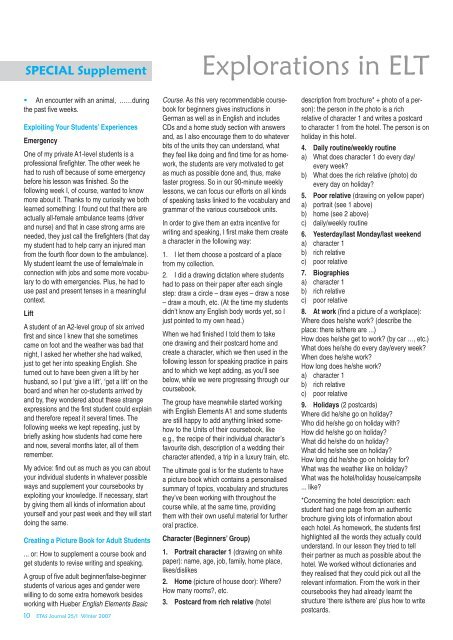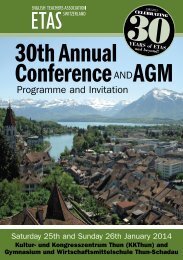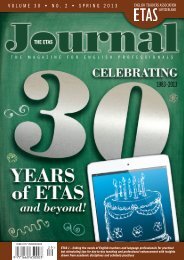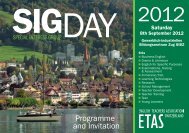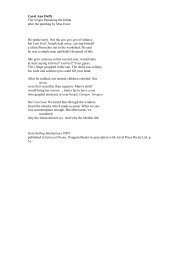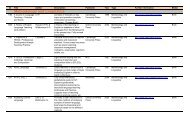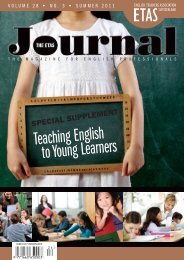The Magazine for English Professionals - English Teachers ...
The Magazine for English Professionals - English Teachers ...
The Magazine for English Professionals - English Teachers ...
Create successful ePaper yourself
Turn your PDF publications into a flip-book with our unique Google optimized e-Paper software.
SPECIAL Supplement Explorations in ELT<br />
� An encounter with an animal, ……during<br />
the past five weeks.<br />
Exploiting Your Students’ Experiences<br />
Emergency<br />
One of my private A1-level students is a<br />
professional firefighter. <strong>The</strong> other week he<br />
had to rush off because of some emergency<br />
be<strong>for</strong>e his lesson was finished. So the<br />
following week I, of course, wanted to know<br />
more about it. Thanks to my curiosity we both<br />
learned something: I found out that there are<br />
actually all-female ambulance teams (driver<br />
and nurse) and that in case strong arms are<br />
needed, they just call the firefighters (that day<br />
my student had to help carry an injured man<br />
from the fourth floor down to the ambulance).<br />
My student learnt the use of female/male in<br />
connection with jobs and some more vocabulary<br />
to do with emergencies. Plus, he had to<br />
use past and present tenses in a meaningful<br />
context.<br />
Lift<br />
A student of an A2-level group of six arrived<br />
first and since I knew that she sometimes<br />
came on foot and the weather was bad that<br />
night, I asked her whether she had walked,<br />
just to get her into speaking <strong>English</strong>. She<br />
turned out to have been given a lift by her<br />
husband, so I put ‘give a lift’, ‘get a lift’ on the<br />
board and when her co-students arrived by<br />
and by, they wondered about these strange<br />
expressions and the first student could explain<br />
and there<strong>for</strong>e repeat it several times. <strong>The</strong><br />
following weeks we kept repeating, just by<br />
briefly asking how students had come here<br />
and now, several months later, all of them<br />
remember.<br />
My advice: find out as much as you can about<br />
your individual students in whatever possible<br />
ways and supplement your coursebooks by<br />
exploiting your knowledge. If necessary, start<br />
by giving them all kinds of in<strong>for</strong>mation about<br />
yourself and your past week and they will start<br />
doing the same.<br />
Creating a Picture Book <strong>for</strong> Adult Students<br />
... or: How to supplement a course book and<br />
get students to revise writing and speaking.<br />
A group of five adult beginner/false-beginner<br />
students of various ages and gender were<br />
willing to do some extra homework besides<br />
working with Hueber <strong>English</strong> Elements Basic<br />
10 ETAS Journal 25/1 Winter 2007<br />
Course. As this very recommendable coursebook<br />
<strong>for</strong> beginners gives instructions in<br />
German as well as in <strong>English</strong> and includes<br />
CDs and a home study section with answers<br />
and, as I also encourage them to do whatever<br />
bits of the units they can understand, what<br />
they feel like doing and find time <strong>for</strong> as homework,<br />
the students are very motivated to get<br />
as much as possible done and, thus, make<br />
faster progress. So in our 90-minute weekly<br />
lessons, we can focus our ef<strong>for</strong>ts on all kinds<br />
of speaking tasks linked to the vocabulary and<br />
grammar of the various coursebook units.<br />
In order to give them an extra incentive <strong>for</strong><br />
writing and speaking, I first make them create<br />
a character in the following way:<br />
1. I let them choose a postcard of a place<br />
from my collection.<br />
2. I did a drawing dictation where students<br />
had to pass on their paper after each single<br />
step: draw a circle – draw eyes – draw a nose<br />
– draw a mouth, etc. (At the time my students<br />
didn’t know any <strong>English</strong> body words yet, so I<br />
just pointed to my own head.)<br />
When we had finished I told them to take<br />
one drawing and their postcard home and<br />
create a character, which we then used in the<br />
following lesson <strong>for</strong> speaking practice in pairs<br />
and to which we kept adding, as you’ll see<br />
below, while we were progressing through our<br />
coursebook.<br />
<strong>The</strong> group have meanwhile started working<br />
with <strong>English</strong> Elements A1 and some students<br />
are still happy to add anything linked somehow<br />
to the Units of their coursebook, like<br />
e.g., the recipe of their individual character’s<br />
favourite dish, description of a wedding their<br />
character attended, a trip in a luxury train, etc.<br />
<strong>The</strong> ultimate goal is <strong>for</strong> the students to have<br />
a picture book which contains a personalised<br />
summary of topics, vocabulary and structures<br />
they’ve been working with throughout the<br />
course while, at the same time, providing<br />
them with their own useful material <strong>for</strong> further<br />
oral practice.<br />
Character (Beginners’ Group)<br />
1. Portrait character 1 (drawing on white<br />
paper): name, age, job, family, home place,<br />
likes/dislikes<br />
2. Home (picture of house door): Where?<br />
How many rooms?, etc.<br />
3. Postcard from rich relative (hotel<br />
description from brochure* + photo of a person):<br />
the person in the photo is a rich<br />
relative of character 1 and writes a postcard<br />
to character 1 from the hotel. <strong>The</strong> person is on<br />
holiday in this hotel.<br />
4. Daily routine/weekly routine<br />
a) What does character 1 do every day/<br />
every week?<br />
b) What does the rich relative (photo) do<br />
every day on holiday?<br />
5. Poor relative (drawing on yellow paper)<br />
a) portrait (see 1 above)<br />
b) home (see 2 above)<br />
c) daily/weekly routine<br />
6. Yesterday/last Monday/last weekend<br />
a) character 1<br />
b) rich relative<br />
c) poor relative<br />
7. Biographies<br />
a) character 1<br />
b) rich relative<br />
c) poor relative<br />
8. At work (find a picture of a workplace):<br />
Where does he/she work? (describe the<br />
place: there is/there are ...)<br />
How does he/she get to work? (by car …, etc.)<br />
What does he/she do every day/every week?<br />
When does he/she work?<br />
How long does he/she work?<br />
a) character 1<br />
b) rich relative<br />
c) poor relative<br />
9. Holidays (2 postcards)<br />
Where did he/she go on holiday?<br />
Who did he/she go on holiday with?<br />
How did he/she go on holiday?<br />
What did he/she do on holiday?<br />
What did he/she see on holiday?<br />
How long did he/she go on holiday <strong>for</strong>?<br />
What was the weather like on holiday?<br />
What was the hotel/holiday house/campsite<br />
... like?<br />
*Concerning the hotel description: each<br />
student had one page from an authentic<br />
brochure giving lots of in<strong>for</strong>mation about<br />
each hotel. As homework, the students first<br />
highlighted all the words they actually could<br />
understand. In our lesson they tried to tell<br />
their partner as much as possible about the<br />
hotel. We worked without dictionaries and<br />
they realised that they could pick out all the<br />
relevant in<strong>for</strong>mation. From the work in their<br />
coursebooks they had already learnt the<br />
structure ‘there is/there are’ plus how to write<br />
postcards.


